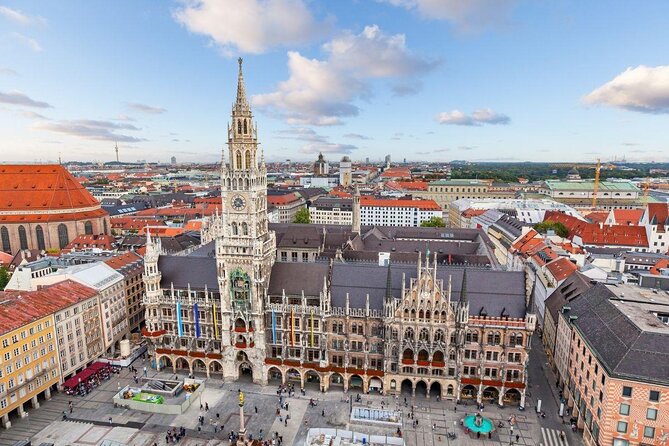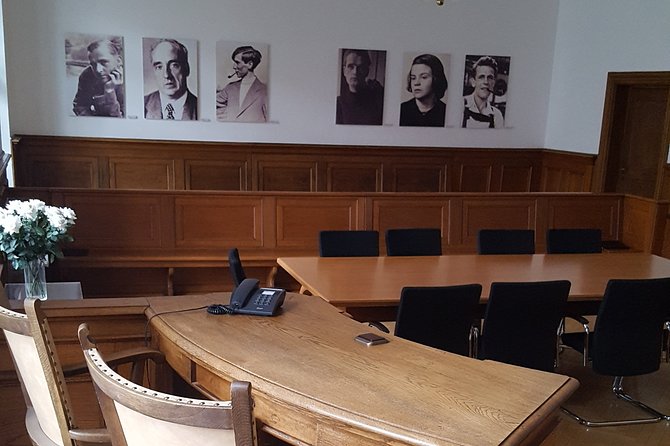Embarking on a journey through Munich’s history, one uncovers the remarkable tales of German resistance to Hitler. Amidst the shadows of oppression, a brave few dared to challenge tyranny, shaping a narrative of courage and defiance.
As the story unfolds, the clandestine activities of the ‘White Rose’ movement and the pivotal role of key figures come to light, offering a glimpse into a lesser-explored facet of World War II.
With each step through the city’s historic sites, the legacy of resistance beckons, inviting exploration into the depths of human resilience and the enduring spirit of dissent.
Good To Know

- Munich’s resistance movements, like the White Rose, defied Hitler’s regime through non-violent actions.
- Key figures like Sophie Scholl and Hans Scholl symbolized bravery and moral conscience in opposing tyranny.
- Sites in Munich, like the White Rose Memorial, commemorate the sacrifices made by those who resisted.
- The legacy of Munich’s resistance movement endures through memorials, events, and ongoing educational programs.
Historical Background
Frequently overlooked in mainstream history lessons, the German resistance movement in Munich during World War II played a significant role in challenging Hitler’s reign of terror.
Within this historical context, the resistance in Munich employed various strategies to oppose the Nazi regime, including distributing anti-Nazi leaflets and engaging in acts of sabotage. These resistance strategies had a profound impact on society by inspiring hope and defiance against the oppressive regime.
The educational significance of studying this resistance lies in understanding the power of ordinary citizens to stand up against tyranny, even in the face of extreme danger. By delving into the resistance movement in Munich, one gains insight into a lesser-known aspect of World War II history that exemplifies courage, resilience, and the fight for freedom.
Find more activities and experiences we've covered in Munich.
Key Figures in the Resistance
Among the key figures in the Munich resistance movement against Hitler, one standout individual was Sophie Scholl, a courageous young woman who played a pivotal role in the anti-Nazi efforts. Sophie, along with her brother Hans, was part of the White Rose resistance group, actively distributing anti-Nazi leaflets to spread awareness and promote resistance strategies.
Other notable key figures in the resistance included:
- Hans Scholl: Brother of Sophie, he co-founded the White Rose movement and was instrumental in organizing resistance activities.
- Alexander Schmorell: A medical student who joined the White Rose and played a crucial role in the group’s operations.
- Christoph Probst: Another key member of the White Rose, he contributed significantly to the resistance efforts.
- Willi Graf: A core member of the resistance group, involved in distributing pamphlets and spreading anti-Nazi sentiments.
- Kurt Huber: A professor who provided intellectual guidance to the White Rose movement, influencing their resistance strategies.
The White Rose Movement

Sophie Scholl and her fellow members of the Munich resistance movement formed the White Rose, a courageous group that defied Hitler’s regime through distributing anti-Nazi materials and advocating for resistance strategies.
The White Rose holds significant importance in history for its non-violent approach to resisting the Nazi regime, inspiring others to stand up against tyranny.
Their impact on the resistance movement was profound, as they symbolized the bravery and moral conscience needed to challenge oppressive authority.
The group’s actions sparked discussions, raised awareness, and encouraged dissent among the German population.
The White Rose’s legacy continues to serve as a reminder of the power of peaceful resistance in the face of totalitarian rule.
Munich’s Anti-Nazi Activities
In Munich, various clandestine groups and individuals engaged in daring acts of resistance against the Nazi regime during World War II. Despite the risks involved, these anti-Nazi activities played a crucial role in opposing Hitler’s oppressive regime.
Some of the impactful memorials and their modern relevance include:
- The White Rose movement’s leaflet distribution at the Ludwig Maximilian University.
- The assassination attempt on Hitler at the Bürgerbräukeller in 1939.
- The Rosenstrasse protest where non-Jewish women demanded the release of their Jewish husbands.
- The formation of the Edelweiss Pirates, a youth resistance group that defied Nazi authority.
- The creation of the Schwabing Art Group, which used art as a form of anti-Nazi expression.
Sites of Resistance in the City
Discover the hidden corners and poignant landmarks that bear witness to the courageous acts of resistance against the Nazi regime scattered throughout Munich’s historic streets. When exploring the city, visitors can uncover various resistance landmarks that served as hubs for underground movements. These sites provide a glimpse into the bravery and determination of those who risked their lives to oppose Hitler’s regime. Here is a sneak peek at some of the notable locations:
| Resistance Landmarks | Description | Significance |
|---|---|---|
| Hofbräukeller | Meeting point for | Birthplace of failed |
| anti-Nazi conspirators | assassination attempt on | |
| during Beer Hall Putsch | Hitler in 1939 | |
| Ludwig Maximilian | University where White | Educational hub for the |
| University | Rose members distributed | White Rose resistance |
| anti-Nazi leaflets | group during WWII | |
| White Rose Memorial | Commemorative site | Honors the members of the |
| Memorial | dedicated to the | White Rose who were |
| White Rose resistance | executed by the Nazis |
These sites offer a tangible connection to the past and a profound insight into the struggles faced by those who fought against tyranny.
Legacy and Commemoration
As visitors reflect on the sites of resistance in Munich, the legacy and commemoration of those who bravely opposed Hitler’s regime continue to resonate throughout the city’s historic streets. This remembrance is kept alive through various means, including:
Annual memorial events honoring the individuals who stood up against tyranny.
Plaques and memorials scattered throughout the city, serving as poignant reminders of the sacrifices made.
Educational programs and tours that shed light on the stories of courage and defiance.
The White Rose Museum, dedicated to preserving the memory of the resistance group and their contributions.
Ongoing research and publications that delve deeper into the lives of the resisters, ensuring their legacy endures for future generations.
Frequently Asked Questions
Are There Any Specific Anecdotes or Lesser-Known Stories About the Resistance Movement in Munich That Are Not Covered in the Article?
When discussing personal sacrifices and underground networks related to the resistance movement in Munich, one uncovers untold stories of bravery and determination. These narratives shed light on the clandestine acts of heroism during dark times.
How Did the Local Community in Munich React to the Activities of the White Rose Movement During World War Ii?
The local community in Munich showed mixed reactions to the White Rose movement during World War II. While some displayed solidarity and support, others were fearful of the consequences. This diversity of responses highlights the complexity of wartime circumstances.
What Impact Did the Resistance Movement in Munich Have on the Broader Anti-Nazi Efforts in Germany During That Time?
The resistance movement in Munich significantly impacted broader anti-Nazi efforts in Germany, influencing propaganda and promoting German unity. Through innovative tactics and underground networks, their actions inspired resistance across the nation, challenging the Nazi regime.
Were There Any Repercussions Faced by Those Involved in the Resistance Movement in Munich After the War Ended?
After the war ended, those involved in the Munich resistance movement faced severe repercussions. Personal stories reveal the harsh aftermath, highlighting community reactions to their bravery. Their sacrifices left a lasting impact on the fight against Nazi tyranny.
How Has the Memory of the Resistance Movement in Munich Been Preserved and Commemorated in Modern-Day Germany?
The memory of the Munich resistance movement is preserved through education, remembrance, and commemoration. Various initiatives honor the bravery of those involved, ensuring their legacy endures in modern-day Germany, inspiring future generations with their courageous acts.
The Sum Up
Experience the bravery and defiance of Munich’s resistance to Hitler through the captivating stories of the White Rose movement. Explore key sites of anti-Nazi activities and honor the legacy of those who dared to challenge tyranny.
Join this immersive tour to uncover the hidden history of German resistance in Munich and gain a deeper understanding of the individuals who stood up against oppression during World War II.
A truly enlightening journey through time awaits you.
More Tour Reviews in Munich
Looking for something different? Other Munich activities we've written about
- All-inclusive Munich Beer, Brewery & Oktoberfest Experience!
- Day trip to the Alps in a convertible self-drive or passenger
- 2-Hour Segway Discovery Tour Munich
- 2-Hour Segway Discovery Munich Night Tour
- Munich Private Walking Tour With A Local Guide
- Munich Interactive City Tour
- Private Salzburg Tour with English Speaking Driver from Munich
- Munich Guided Pubcrawl with Free Shots and VIP Club Entry
- Private Munich City and Dachau former Concentration Camp day Tour
- Private Group Tour in Munich’s Alte Pinakothek
- Hike Herzogstand: Private Tour from Munich, great for beginners!
- Munich in 500 Years: An Architectural Time Machine
